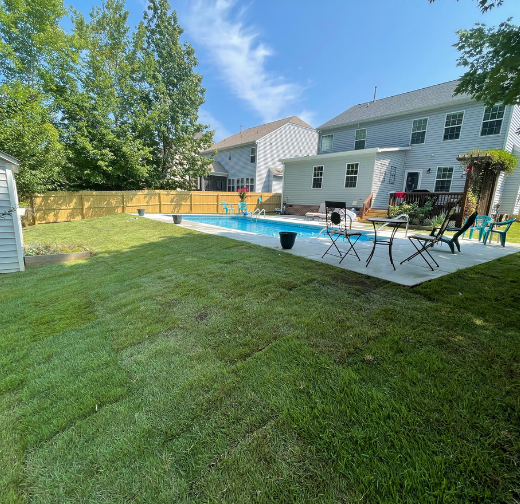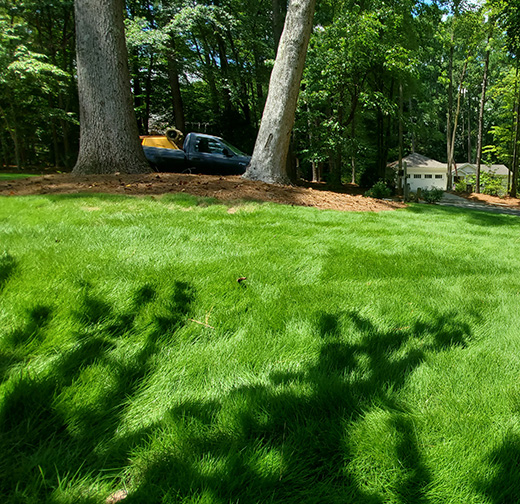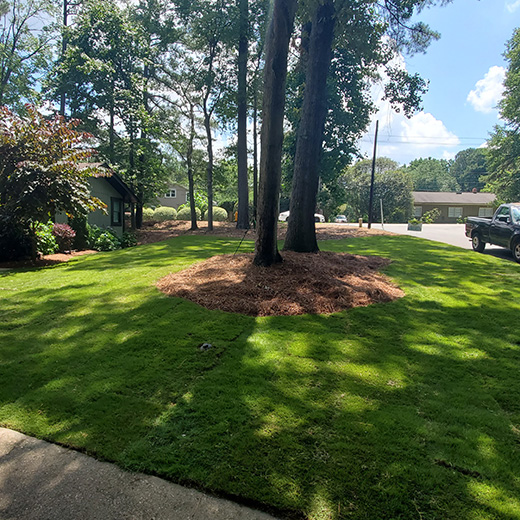Looking to find "sod near me"?
Sod installs are our specialty and for us that starts with quality sod. If you’ve been searching for “sod near me”, discover our Spring 2024 Sod Grass Types for Home Installations Now!
Spring 2024 Sod Grass Types
As Green Grass Growth specialists, we know a successful sod installation starts with great grass. We’ve selected our sourcing partners for the season and are excited to offer homeowners across Southern Wake County the following sod grasses for Spring 2024.

Industry-standard for Zoysia
Medium/Coarse Blade
Great density
Shade tolerance (4-6 hours sun requirement)
Low mowing requirements (slow-growing)
Drought tolerant
Lime green coloring

Highest grade Bermuda
Great thickness and blue-green color
The best drought tolerance. Requires little to no watering once established outside of rain
Can be rooted as quickly as a week
Great cold tolerance. Sometimes does not even go dormant under certain conditions
Can handle shade better than most Bermuda grasses
Very tolerant to general wear and tear
Ideal for the customer looking for low maintenance and quick recovery

Builder Grade Bermuda
Looks good if taken care of
More drought tolerant than Fescue, but will require regular watering to maintain hardiness and color
Roots quickly
Perfect for someone on a budget
Requires full sun and will thin out in shaded areas
Poor cold tolerance. Will go dormant the first frost.

Medium grade Zoysia
Upright, wide grass blade
Great drought tolerance
Middle range pricing
Good bright green color
Grows slow and does not need to be cut often
Good shade tolerance (5 hours of sunlight daily)
Great density

Premium grade Zoysia
Soft to the touch, fine grass blade
Deep green color
Most drought tolerant Zoysia
Highest priced turf
Grows slow and does not need to be cut often
Very little thatch build up
Great shade tolerance (4 hours daily sun requirement)
Great density
More resistant to weeds due to dense root system

Medium-Wide flat blade which hugs the ground
Medium root density
Sun-loving (7–8 hours minimum required)
Drought tolerant
Mow every 10-14 days at 1-2″
Kelly green color
Repairs itself with runners at a slow rate of speed
Budget-friendly
Fertilize once a year with low Nitrogen frertlizer (5-10-30)
Good choice for coastal NC and the Sandhills
Very chemical sensitive – do not use standard lawn products
Spring 2024 Sourcing Partners: The Best Sod from Local Sod Farmers
At Peak Sodding, sourcing the best sod is a priority. We understand the investment our homeowners are making when replacing a lawn and want to ensure the grass for the lawns we install is locally sourced and of the highest quality.
We are happy to introduce our Spring 2024 Sourcing Partners.
Each of these local sod farms has been shown to consistently deliver to us well-cut rolls of good color and fertilization and through our extensive inspection and testing process, we can confidently say these sod suppliers are offering the best sod this season.

Why Finding “Sod Near Me” Is Important?
Finding sod near your home is important so it is as fresh as possible and accustomed to growing in the area’s climate.
Nothing is more disappointing than to hear stories of unsuccessful installations where homeowners overlooked the importance of choosing quality sod but did choose the right grass type for the lawn’s environment, had it professionally installed, and followed proper watering practices after installation.
As sod installation specialists, we understand that quality sourced sod is a critical step. It’s also why it’s the first step in our Green Grass Growth process.
Quality Sod Inspection Checklist
During our seasonal inspections, we use a Quality Sod Inspection Checklist to evaluate the local area’s sod suppliers. This inspection checklist gives us confidence a new lawn installation is given the best possible start for 5-star success.
Sod Inspection Checklist
- Sod Delivery – Does a sod farm deliver rolled or in slabs? Our preference is rolled for a faster install with less time on the pallet. We aim to lay sod fresh for our homeowners within 24-48 hours of it being cut from the farm. We also check that the sod has been rolled inside for protection. A red flag for us is sod rolled to the outside.
- Sod Thickness – Thickness varies but we look for at least 1 inch to ensure a healthy root system.
- Grass Color – Sod types vary in color but uniform color signifies overall health. Healthy sod is needed prior to installation in order to have ample time for the sod to root after it is installed in your yard.
- Weed and Insect Free – We inspect sod for weeds and insects prior to acceptance to confirm its health.
- Moisture Level – By touching the back of the sod, our team can determine whether the sod was watered frequently prior to being freshly cut from the farm.
- Density – Tightly grown sod indicates an established root system. We test sod by pulling individual blades to see how easily they detach from the dirt layer.

Seasonal Sod Varieties
Climate plays a role in what type of sod will thrive or die on your lawn.
Your choice of turf should be dependent on your specific needs (both in the demands of the grass and tolerance for some situations) but it’s also important to consider whether the grass is ideal for our area’s climate.
Selecting the right sod for North Carolina can be tricky as we are in the middle of the country where temperatures fluctuate more drastically than some of the more northern and southern areas.
Understanding the difference between seasonal sod varieties is important as different sod varieties grow better in some geographic locations more than others.
What To Know About Seasonal Sod Varieties
What to know: Warm Season Grass
Warm-season grass grows best in the hot summers and lacks the hardiness for harsh winters. Examples of Warm Season Grass are Bermuda, Zoysia, Centipede, and St. Augustine.
What to know: Cool Season Grass
Cool-season grass grows fastest during the fall and spring and also stays green until temperatures dip below 32 degrees or above 90 degrees. Colder climates benefit from these types of sod grasses: Fine and Tall Fescues, Kentucky BlueGrass, Bentgrass, and Ryegrasses.
4-Step Grass Assessment
Peak Sodding advises homeowners with what’s the right sod for North Carolina and their lawn with a 4-step Grass Assessment.
- Maintenance Needs (Mowing, Fertilization, Irrigation)
- Tolerance Needs (Temperature, Wear, Shade)
- Our Area’s Seasonal Needs
- Preferred Installation Date
If you’d like our help in selecting the right sod for your North Carolina project, contact us today!
The Right Sod For Your Lawn
What’s your lawn environment? Lack of sunlight, too much sun, or heavy traffic from a dog or two? Peak Sodding solves lawn challenges by selecting, then installing, the right sod for the lawn environment.

Lawn Challenge
Due to the lack of ample sunlight and the nutrient value the sun offers, shady lawns have a tendency to experience loss of density. This can be very problematic for many warm season varieties as the nutrients from the sun allow for increased “leafing”, thus lack of sun will greatly affect thickness.
Sod Recommendation
Yards that have a lot of shade need turf that not only prefer cooler weather, but that can survive freely without the typical required 6 hours of sunlight per day. Fescue and higher grade Zoysia varieties have shown much better tolerance to shady conditions.
Best Time to Sod
Early spring is a great time to install sod for a shady lawn. For Fescue, it is optimal to have the sod laid in Fall due to its cool-season nature.

Lawn Challenge
Full sun yards can pose drought challenges when temperatures start to rise. Not only so, but those with clay soil run into another problem of the clay hardening and compacting during the hotter seasons. Grass that is not meant for full sun can quickly die or the water bill can start to go sky high.
Sod Recommendation
Yards with full sun need a sod capable of tolerating the hot temperatures and dry climates, especially in the summer with high heat days and long days of sun. Bermuda thrives under conditions like these with the higher grade varieties like TifTuf being able to survive entire Summers with minimal water.
Best Time to Sod
With the right grass type, a new lawn installation for a full-sun lawn is acceptable year-round with the optimal times being early Spring – mid Summer.

Lawn Challenge
Lawns that require lots of water or mowing can prove to be a headache for many homeowners.
Sod Recommendation
If lawn care is not something you enjoy, consider a grass type that grows more slowly and has a high drought tolerance such as Zoysia or Bermuda. Zoysia performs exceptionally for those looking for minimal mowing and lesser watering requirements. For those who don’t mind the mowing, but want to save on the water bill, Bermuda is the most drought-tolerant option. Due to their self recovering ability, both Bermuda and Zoysia also do not require yearly reseeding.
Best Time to Sod
Sodding during the dormant season can save you significant amounts of time and trouble watering as the dormant sod has very minimal watering requirements during the rooting period.

Lawn Challenge
Heavy traffic yards are prone to a greater amount of wear and tear. The consistent stress on your grass can quickly create bare patches if the right sod is not installed.
Sod Recommendation
Yards that suffer from consistent and frequent usage need to be capable of recovering quickly from the daily traffic. Bermuda is a good solution for high traffic yards. It is often the most common choice for athletic fields and golf courses due to its exceptional recovery ability without the need to reseed.
Best Time to Sod
March-August is ideal for installing a Bermuda turf variety as it is a warm-season grass.
Across Southern Wake County
The Peak Sodding team travels across Southern Wake County to deliver lawn solutions for homeowners. We document the transformations and challenges we solve for homeowners so others can see the work we do.
